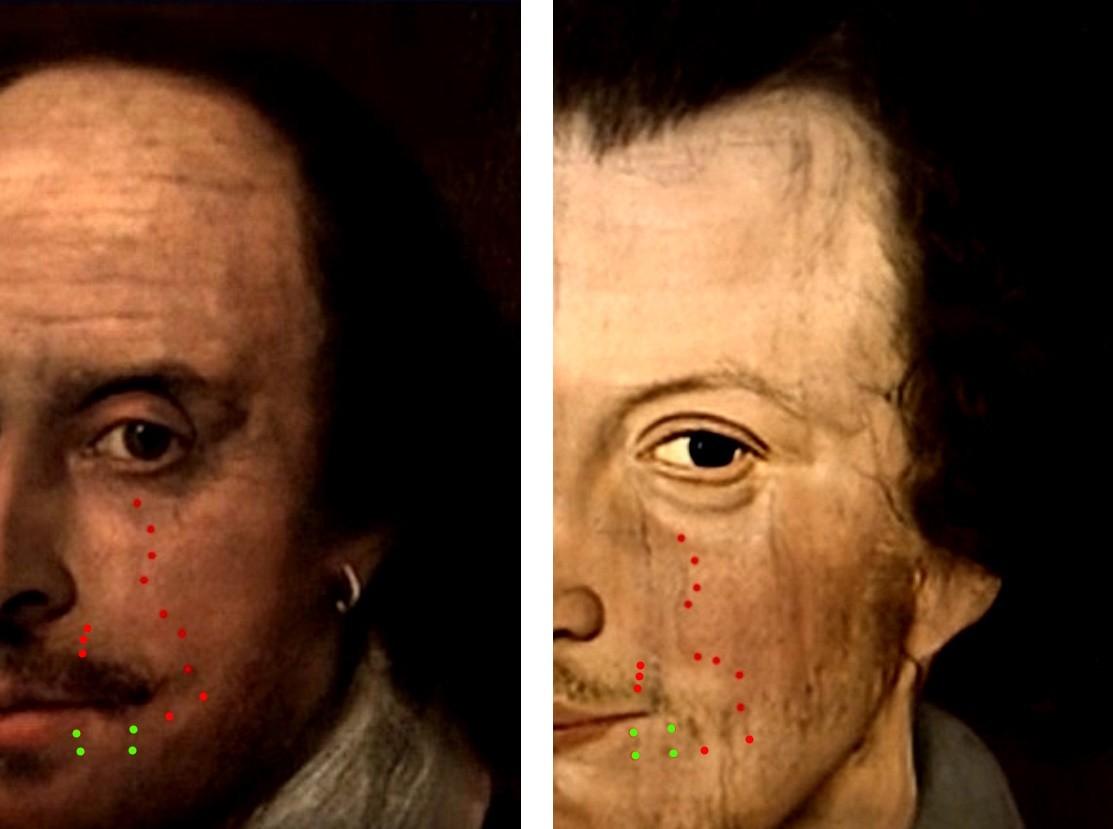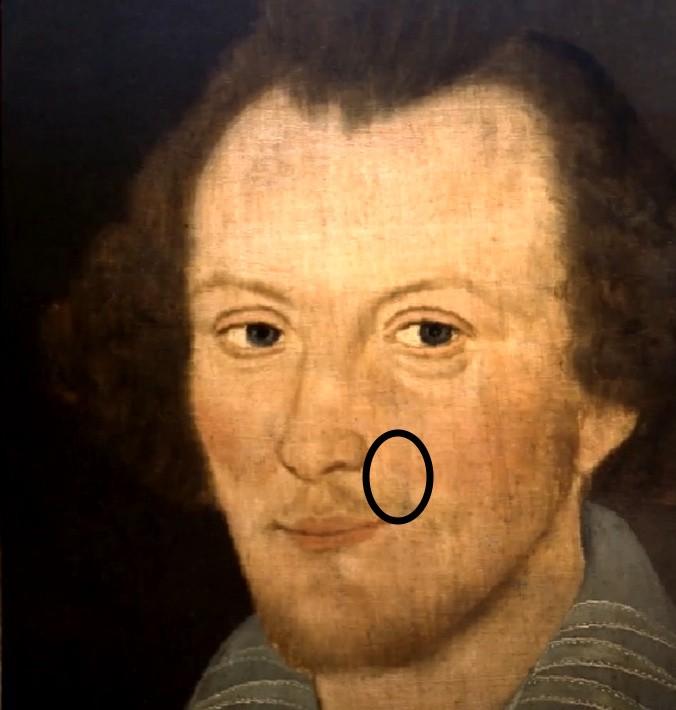THOSE SHAKESPEARE LIFELONG FACE SCARS ARE LIKE FINGERPRINTS CONFIRMING THE AUTHENTICITY OF THE SANDERSANDCHANDOSPAINTINGS
The most popularly accepted representation of Shakespeare (WS) the Chandos painting was done according to George Vertue by John Taylor, a player who acted for WS. Taylor was also a good friend of WS like John Sanders who did the Sanders painting of WS. So it is likely that Taylor knew Sanders and was aware of his painting. The Fig. 1 does show striking similarities between the Chandos and the Sanders painting at the level of major face scars under the left eye of WS and above the mouth.
A B



Fig. 1, The left side of the sitters in the Chandos painting (A) and the Sanders painting (B) following the AI cleaning. The smaller upper right pictures are the untreated artworks. In both images large swellings or scars running from the corner of the left eye and going around the left corner of the mouth are indicated with red dots while the green dots show another common scar below the left corner of the mouth. Just above the mustache three round marks also common to both pictures are shown by red dots.
First in Fig. 1 the best painting images were chosen and those pictures were then ''cleaned'' by a recent AI technology developped by MyHeritage Deep Nostalgia (myheritage.com/deep-nostalgia) which enables the enhancement of resolution and sharpens the face appearing in them.
In Fig. 1, striking similarities are detected, indeed the swellings or scars running from below the left eye to the left corner of the mouth (red dots) as well as the swelling or scar right under the mouth left corner (green dots) are easily observed in both the Sanders (Fig.1B) and the Chandos (Fig. 1A) paintings. However the stronger beard of the sitter in the Chandos painting does hide the larger scars observed in the Sanders painting going down the cheek or toward the chin. The three round marks above the mustache are part of the Stirling observation previously described in the Chandos painting and also recently found in the Stratford bust of WS.
Another common facial feature between the Chandos and the Sanders paintings is shown in Fig. 2.
A

B

Fig. 2, Another scar points out by the black circle just above the left corner of the mouth found common to the Chandos and the Sanders paintings.
The Fig. 2 describes a scar of particular shape looking like this and detected in both paintings.

As expected less severe swellings or scars are found in the sitter of the Chandos painting (done around 1610) showing WS at an older than the one in
the Sanders painting (1603), time has partially healed those facial wounds in the Chandos painting.
So the AI cleaning did not removed those swelling or scars. They are not artefacts or the results of poor restoration, they are WS facial features that the painters wanted to reproduce in the Chandos and the Sanders paintings (Fig.1and 2). Other common scars could be identified on those figures but the aim of this study is already fulfilled and this short study is the strongest evidence that the sitters in those paintings do represent the same person The Bard.
Furthermore as mentioned previously since it was likely that Taylor and Sanders knew each other and considering those common identical facial features shown in Fig. 1 and 2, it is clearly possible that Taylor used the Sanders painting as the model for his own painting. Sanders got the opportunity to capture WS still at his prime time, at a younger age but with the lifelong facial wounds which were later reproduced by Taylor in what became the Chandos painting.
Jean-Pierre
Doucet 04 23 2025
Notes:
As reported by Simon Andrew Stirling, at the age of 18 in 1582, WS was involved somehow in a brutal fight and came out with scars close to the left eye which remained visible for the rest of his life.
An art critic wrote that he would never believe that the sitter shown in the Sanders painting done in 1603 might become the sitter painted in the Chandos painting done around 1610. But it was forgetting that during WS time (outbreaks of diseases, limited medical knowledge, lack of sanitation, etc) ‘’the span of life on the average was shorter then and the ravages of years much quicker in consequence’’ (from Sharp Ogden).
MAIN REFERENCES:
Sharp Ogden W. (1912) SHAKSPERE’S PORTRAITURE: PAINTED, GRAVEN, AND MEDALLIC, The British Numismatic Journal, Vol. VII 1910.1, Bernard Quaritch editor, London, 58 pages.
Hammerschmidt-Hummel H. (2006) The True Face of William Shakespeare, The poet's death mask and likenesses from three periods of his life, Chaucer Press, 2008 pages.
Doucet J.-P., THE KEY LEARNINGS FROM THE FINEST DROESHOUT’S ENGRAVING OF SHAKESPEARE
https://free.relayto.com/jeanpierre-doucet/the-key-learnings-from-the-finestdroeshout-s-engraving-of-shakespeare-42s5fmb0qx9ms/JuKWgoyT1
Doucet J.-P., THE SANDERS PAINTING IS DEEMED TO BE AN AUTHENTIC PORTRAIT OF SHAKESPEARE,
https://free.relayto.com/jeanpierre-doucet/the-sanders-painting-and-itsauthenticity-as-a-portrait-of-shakespeare-u5a1mfrhq4c7i/EHKHsvjp1
Doucet J.-P., THE MISSING LINK BETWEEN THE STRATFORD BUST AND SOME GENUINE PAINTIINGS OF SHAKESPEARE
https://www.youtube.com/watch?v=nsx9aneJYBs
Stirling S.A., Art & Will, artandwill.blogspot.com/2014/03/shakespearescrab.html.
Stirling S. A.,The Faces of Shakespeare: Revealing Shakespeare's Life and Death Through Portraits and Other Objects
https://www.gold.ac.uk/glits-e/back-issues/the-faces-of-shakespeare-revealingshakespeares-/
